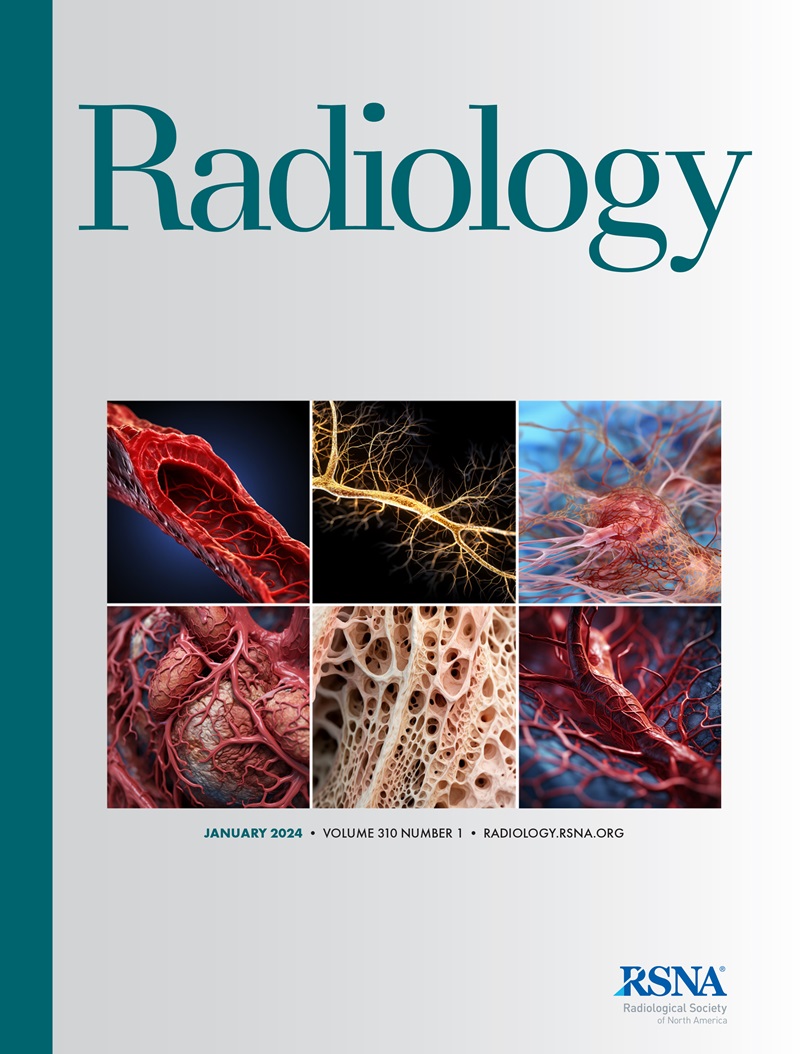Detection Rates of Ductal Carcinoma in Situ with Biennial Digital Mammography Screening: Radiologic Findings Support Pathologic Model of Tumor Progression.
IF 15.2
1区 医学
Q1 RADIOLOGY, NUCLEAR MEDICINE & MEDICAL IMAGING
Stefanie Weigel, Laura Khil, Hans-Werner Hense, Thomas Decker, Jürgen Wellmann, Jan Heidrich, Alexander Sommer, Oliver Heidinger, Walter Heindel
下载PDF
{"title":"Detection Rates of Ductal Carcinoma in Situ with Biennial Digital Mammography Screening: Radiologic Findings Support Pathologic Model of Tumor Progression.","authors":"Stefanie Weigel, Laura Khil, Hans-Werner Hense, Thomas Decker, Jürgen Wellmann, Jan Heidrich, Alexander Sommer, Oliver Heidinger, Walter Heindel","doi":"10.1148/radiol.2017170673","DOIUrl":null,"url":null,"abstract":"<p><p>Purpose To compare detection rates of ductal carcinoma in situ (DCIS), classified according to nuclear grade, between the prevalence round (baseline screening) and two subsequent screening rounds of a population-based digital mammography screening program, to assess differences over time. Materials and Methods The cancer registry provided data for 1970 graded pure DCIS cases from 16 screening regions of the prevalence round (baseline screening, from 2005 to 2008), first subsequent round, and second subsequent round; the interval between all screening rounds was 22-30 months. Age-adjusted logistic regression analysis was performed to compare the grade-specific detection rates between the prevalence round (reference) and subsequent screening rounds. Results Over all screening rounds, cancer detection rates were lowest for low-grade DCIS (range, 0.11 [58 of 508 817 patients] to 0.25 [178 of 713 867 patients] per 1000 women screened) and highest for high-grade DCIS (range, 0.53[271 of 508 817 patients] to 0.59 [237 of 398 944 patients] per 1000 women screened). Detection rates for low-grade DCIS were significantly lower in the first (odds ratio [OR] = 0.45, P < .001) and second (OR = 0.57, P < .001) subsequent screening rounds compared with that in the prevalence round; the relative reduction of detection rates of intermediate-grade DCIS was less pronounced (OR = 0.79, P = .006 and OR = 0.76, P = .003, respectively). Conversely, the detection rate of high-grade DCIS remained at the high level found in the prevalence screening (OR = 0.89, P = .143 and OR = 0.97, P = .700, respectively). Conclusion The findings demonstrate persistently high detection rates of high-grade DCIS in two consecutive subsequent screening rounds compared with the prevalence round; conversely, rates of low-grade DCIS and, less markedly, intermediate-grade DCIS decreased in subsequent rounds. Grade-related changes of DCIS detection are suggestive of distinct dynamics of lesion progression. <sup>©</sup> RSNA, 2017 An earlier incorrect version of this article appeared online. This article was corrected on November 10, 2017.</p>","PeriodicalId":20896,"journal":{"name":"Radiology","volume":"286 2","pages":"424-432"},"PeriodicalIF":15.2000,"publicationDate":"2018-02-01","publicationTypes":"Journal Article","fieldsOfStudy":null,"isOpenAccess":false,"openAccessPdf":"https://sci-hub-pdf.com/10.1148/radiol.2017170673","citationCount":"16","resultStr":null,"platform":"Semanticscholar","paperid":null,"PeriodicalName":"Radiology","FirstCategoryId":"3","ListUrlMain":"https://doi.org/10.1148/radiol.2017170673","RegionNum":1,"RegionCategory":"医学","ArticlePicture":[],"TitleCN":null,"AbstractTextCN":null,"PMCID":null,"EPubDate":"2017/11/6 0:00:00","PubModel":"Epub","JCR":"Q1","JCRName":"RADIOLOGY, NUCLEAR MEDICINE & MEDICAL IMAGING","Score":null,"Total":0}
引用次数: 16
引用
批量引用
Abstract
Purpose To compare detection rates of ductal carcinoma in situ (DCIS), classified according to nuclear grade, between the prevalence round (baseline screening) and two subsequent screening rounds of a population-based digital mammography screening program, to assess differences over time. Materials and Methods The cancer registry provided data for 1970 graded pure DCIS cases from 16 screening regions of the prevalence round (baseline screening, from 2005 to 2008), first subsequent round, and second subsequent round; the interval between all screening rounds was 22-30 months. Age-adjusted logistic regression analysis was performed to compare the grade-specific detection rates between the prevalence round (reference) and subsequent screening rounds. Results Over all screening rounds, cancer detection rates were lowest for low-grade DCIS (range, 0.11 [58 of 508 817 patients] to 0.25 [178 of 713 867 patients] per 1000 women screened) and highest for high-grade DCIS (range, 0.53[271 of 508 817 patients] to 0.59 [237 of 398 944 patients] per 1000 women screened). Detection rates for low-grade DCIS were significantly lower in the first (odds ratio [OR] = 0.45, P < .001) and second (OR = 0.57, P < .001) subsequent screening rounds compared with that in the prevalence round; the relative reduction of detection rates of intermediate-grade DCIS was less pronounced (OR = 0.79, P = .006 and OR = 0.76, P = .003, respectively). Conversely, the detection rate of high-grade DCIS remained at the high level found in the prevalence screening (OR = 0.89, P = .143 and OR = 0.97, P = .700, respectively). Conclusion The findings demonstrate persistently high detection rates of high-grade DCIS in two consecutive subsequent screening rounds compared with the prevalence round; conversely, rates of low-grade DCIS and, less markedly, intermediate-grade DCIS decreased in subsequent rounds. Grade-related changes of DCIS detection are suggestive of distinct dynamics of lesion progression. © RSNA, 2017 An earlier incorrect version of this article appeared online. This article was corrected on November 10, 2017.
两年一次数字乳房x线摄影筛查导管原位癌的检出率:放射学发现支持肿瘤进展的病理模型。
目的比较以人群为基础的数字化乳房x线摄影筛查项目的流行轮(基线筛查)和随后两轮筛查之间根据核分级分类的导管原位癌(DCIS)的检出率,以评估随时间的差异。癌症登记处提供了来自16个筛查地区的1970例分级纯DCIS病例的数据,包括患病率轮(基线筛查,2005年至2008年)、第一轮和第二轮;所有筛查轮之间的间隔为22-30个月。进行年龄校正logistic回归分析,比较患病率轮(参考)和随后筛查轮之间的年级特异性检出率。在所有筛查轮次中,低级别DCIS的癌症检出率最低(范围为0.11[508 817例患者中的58例]至0.25[713 867例患者中的178例]/ 1000名接受筛查的女性),高级别DCIS的癌症检出率最高(范围为0.53[508 817例患者中的271例]至0.59[398 944例患者中的237例]/ 1000名接受筛查的女性)。低级别DCIS的检出率在第一轮(比值比[OR] = 0.45, P < .001)和第二轮(比值比[OR] = 0.57, P < .001)与患病率轮相比显著降低;中度DCIS检出率的相对降低幅度较小(OR = 0.79, P = 0.006; OR = 0.76, P = 0.003)。相反,在患病率筛查中,高级别DCIS的检出率保持在较高水平(OR = 0.89, P = 0.143, OR = 0.97, P = 0.700)。结论高级别DCIS在后续连续两轮筛查中的检出率高于患病率轮;相反,在随后的轮次中,低级别DCIS和不太明显的中级别DCIS的发生率下降。DCIS检测的分级相关变化提示病变进展的不同动态。©RSNA, 2017这篇文章的早期错误版本出现在网上。本文于2017年11月10日更正。
本文章由计算机程序翻译,如有差异,请以英文原文为准。

 求助内容:
求助内容: 应助结果提醒方式:
应助结果提醒方式:


